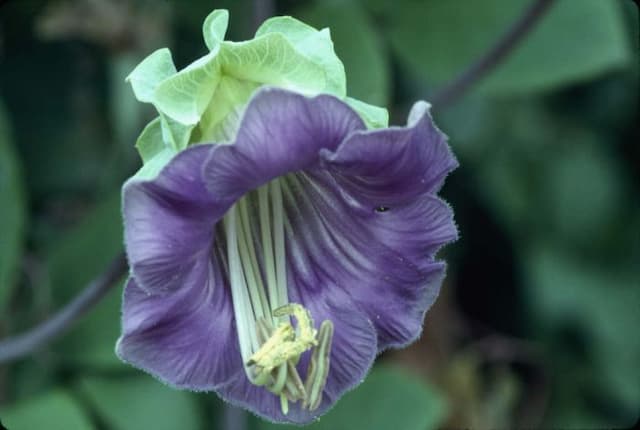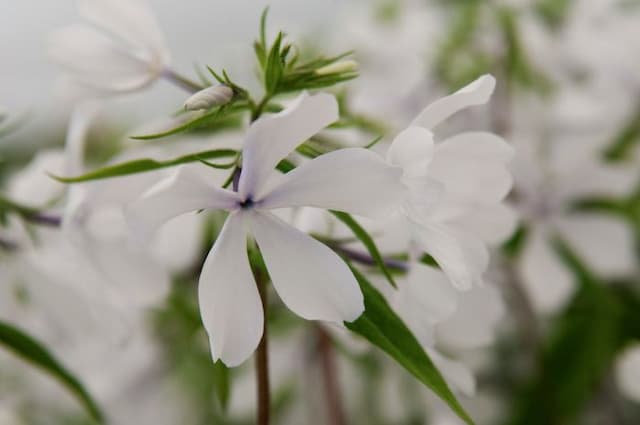Skunkweed Polemonium viscosum

ABOUT
The common name for Polemonium viscosum is Skypilot. This plant is recognized for its attractive appearance, often creating a striking presence in its native alpine and subalpine environments. The foliage consists of ladder-like leaves that are pinnately compound, which means they have a central stem with paired leaflets arranged on either side. The vibrant green of the leaves forms a lush, dense backdrop for the flowers. The flowers of the Skypilot are its most distinguished feature, typically presenting a captivating shade of purple or blue. They are trumpet-shaped and cluster together at the top of the plant's stems in richly packed bunches. Each individual flower comprises a series of rounded petals that flair outward from a narrow base, somewhat resembling a small bell or trumpet. The arrangement of these beautiful flowers gives the plant a delicate and ornamental look, much admired by onlookers and valued by gardeners who seek to add a splash of color to their arrangements. The overall structure of the Skypilot is such that it forms neat, composed clumps of greenery and flowers, giving it a tidy and cohesive look. The balance between its ornate leaves and showy blooms adds to its charm and makes it a popular choice for rock gardens and naturalized spaces, where its appearance can truly shine.
About this plant
 Names
NamesFamily
Polemoniaceae.
Synonyms
Skunkweed, Sticky Polemonium, Sticky Jacob's-ladder, False Jacob's-ladder, Alpine Jacob's-ladder, Alpine Polemonium, Viscid Polemonium.
Common names
Polemonium confertum, Polemonium viscosum var. viscosum, Polemonium pulchellum.
 Toxicity
ToxicityTo humans
Polemonium viscosum, commonly known as Skypilot, is not widely recognized as a poisonous plant to humans. There is limited information available about its toxicity because it is not typically regarded as a species with significant toxic potential. However, caution is always advised when dealing with plants, as sensitivity can vary from person to person. Always consult with a medical professional or a local poison control center if ingestion occurs and any adverse reactions are noticed.
To pets
Skypilot (Polemonium viscosum) is not commonly listed as toxic to pets such as dogs and cats. However, the absence of toxicity reports does not guarantee that it is completely safe. Individual animals could have sensitivity or allergic reactions to plants not widely known to be toxic. If your pet consumes Skypilot and exhibits symptoms such as vomiting, diarrhea, or unusual behavior, it's important to seek veterinary care promptly.
 Characteristics
CharacteristicsLife cycle
Perennials
Foliage type
Deciduous
Color of leaves
Green
Flower color
Blue
Height
1-2 feet (30-60 cm)
Spread
1-1.5 feet (30-45 cm)
Plant type
Herb
Hardiness zones
3
Native area
North America
Benefits
 General Benefits
General Benefits- Attracts pollinators: Polemonium viscosum, commonly known as Sky Pilot, is known to attract bees, butterflies, and other beneficial insects to the garden.
- Aesthetic appeal: With its beautiful clusters of purple or blue flowers, the Sky Pilot adds visual interest and color to alpine and rock gardens.
- Wildlife habitat: The plant can provide shelter and nesting material for various small wildlife, enhancing biodiversity.
- Erosion control: Its root system helps stabilize soil in sloped terrains, reducing the risk of erosion.
- Adaptability: Sky Pilot is well-suited for high-altitude environments, being a resilient plant that is adapted to harsh, mountainous conditions.
- Cultural significance: In some cultures or regions, this plant may have historical value or be associated with traditional gardening practices.
 Medical Properties
Medical Properties- This plant is not used for medical purposes.
 Air-purifying Qualities
Air-purifying QualitiesThis plant is not specifically known for air purifying qualities.
 Other Uses
Other Uses- Polemonium viscosum, commonly known as Sky Pilot, can be used as an ornamental flower in alpine and rock gardens due to its attractive blue to violet flowers and compact growth habit.
- The plant can serve as a marker for hikers in high-altitude regions, as its presence can indicate a certain elevation or type of terrain.
- Sky Pilot can be used in educational settings like botanical gardens to teach about plant adaptation to harsh mountain climates.
- The flowers of the Sky Pilot can be incorporated into photography and art works for their aesthetic appeal and representation of mountain biodiversity.
- The scent of Sky Pilot, which is especially strong when the temperatures are cooler, might be used in creating natural perfumes or scented products.
- These plants could potentially be studied for their evolutionary strategies, as they thrive in environments with extreme temperature fluctuations.
- The Sky Pilot's ability to grow in nutrient-poor soils could be researched for insights into soil conservation and sustainable agriculture.
- Native American tribes have been known to make use of various plants for dyes; the Sky Pilot could be explored as a potential natural source of blue or purple dyes.
- Its presence in the wild can attract pollinators such as bees and butterflies, contributing to the health of the local ecosystem.
- Traditional crafts could utilize the dried stems and flowers of the Sky Pilot for floral arrangements or natural crafting materials.
Interesting Facts
 Feng Shui
Feng ShuiThe plant Skypilot is not used in Feng Shui practice.
 Zodiac Sign Compitability
Zodiac Sign CompitabilityThe plant Skypilot is not used in astrology practice.
 Plant Symbolism
Plant Symbolism- Harmony: The common name for Polemonium viscosum is "Skypilot," which suggests a connection to the divine and a sense of balance and harmony in the natural world.
- Spiritual Guidance: As "Skypilot" is also a term used for a clergyman, especially in the military, the plant could symbolically represent guidance, spiritual direction, and pastoral care.
- Heavenly: With "Sky" in its common name, Skypilot symbolizes what is heavenly or elevated, perhaps indicating a striving towards higher ideals or a connection to the celestial.
- Resilience: Native to high altitudes and rugged terrain, Skypilot could symbolize the ability to adapt and remain strong through adversity.
 Water
WaterSkunky Jacob's Ladder should be watered when the top inch of soil feels dry. It's generally recommended to provide deep watering once or twice a week, depending on the weather conditions and soil type. Each plant should receive about one to one and a half gallons of water during each session, ensuring that the moisture reaches deep into the root zone. Avoid overhead watering to prevent foliar diseases; instead, water at the base of the plant. Always allow the soil to dry slightly between waterings to prevent root rot.
 Light
LightSkunky Jacob's Ladder thrives in partial shade, particularly in the hot afternoon sun. The ideal location is where it can receive morning sun and be protected during the harsh afternoon hours. A spot under a tree that allows dappled sunlight or on the north or east side of a structure would be a perfect choice.
 Temperature
TemperatureSkunky Jacob's Ladder does well in a range of temperatures but prefers cooler conditions. It can survive in temperatures as low as -30 degrees Fahrenheit but ideal growing temperatures are between 60 to 75 degrees Fahrenheit. Temperatures above 90 degrees Fahrenheit can stress the plant, so it should be offered shade and extra moisture during heatwaves.
 Pruning
PruningSkunky Jacob's Ladder should be pruned to remove dead or damaged foliage and to maintain its shape. Light pruning can be done throughout the growing season as needed. The best time to do a more thorough pruning is in the spring before new growth begins or right after the plant has flowered to encourage a second bloom.
 Cleaning
CleaningAs needed
 Soil
SoilSkunky Monkey Flower requires well-draining soil rich in organic matter with a slightly acidic to neutral pH of 5.5 to 7.0. A mix of peat, loam, and sand is ideal to ensure proper drainage and aeration for healthy root growth.
 Repotting
RepottingSkunky Monkey Flower typically does not need frequent repotting; it can be done every 2-3 years or when the plant outgrows its current container. It's best to repot in spring before the growing season begins.
 Humidity & Misting
Humidity & MistingSkunky Monkey Flower thrives in moderate humidity levels. While it can tolerate a range of humidity conditions, it prefers an environment similar to its native mountain habitats—higher humidity but with good air circulation.
 Suitable locations
Suitable locationsIndoor
Provide bright, indirect light and cool temperatures.
Outdoor
Part shade to full sun; protect from midday heat.
Hardiness zone
3-7 USDA
 Life cycle
Life cyclePolemonium viscosum, commonly known as Sky Pilot, begins its life cycle as a seed, which will germinate when conditions are favorable, usually in a moist and cool environment. Upon germination, the seedling emerges, developing a root system and a rosette of basal leaves close to the ground. As it grows, the plant develops a flowering stem and produces clusters of blue to violet flowers, which are typically pollinated by bees and other insects. After pollination, the flowers develop into capsules containing numerous seeds. When the seeds mature, they are dispersed by wind, water, or animal activity to colonize new areas. The plant is a perennial and will go dormant in winter, with the cycle repeating as the weather warms in the spring.
 Propogation
PropogationPropogation time
Spring to Summer
For the plant known commonly as Skypilot or Sticky Polemonium (Polemonium viscosum), the most popular method of propagation is through seeds. The ideal time to sow Skypilot seeds is in spring after the threat of frost has passed or in late autumn to allow for a natural stratification period over winter. To propagate, surface-sow the seeds onto a well-draining soil mix, as Skypilot seeds require light for germination. The soil should be kept moist but not soggy, and the seeds generally germinate in 15 to 30 days at temperatures around 70°F (approximately 21°C). If starting the seeds indoors, it's beneficial to provide seedlings with strong light to prevent legginess and to harden off plants gradually before transplanting outside once all risk of frost is past and they've grown large enough to handle.









